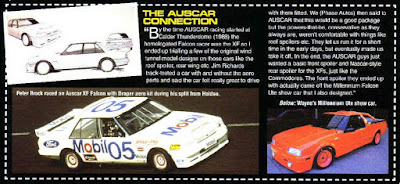That's 1988, in the middle of Peter's divorce with Holden, and there he is steering an XF Falcon AUSCAR at the Calder Park Thunderdome. So many Brock fans never made it past the denial stage of grief and prefer to forget that he ever drove Fords, or at least console themselves that, "He never put a Ford sticker on his Sierra."
But there's no getting around this one. In 1988 Brock was racing a BMW in touring cars, and the Sierra was in the future. But sponsors call the shots, and when Bob Jane opened the Thunderdome, Mobil decreed that Brock must race there. And after that messy Polarizer business he could hardly go and knock on Holden's door and ask for a spare Commodore, could he? So that's the famous #05, on the door of a Falcon, with Mobil sponsorship and proper blue-oval sticker. The man who once said, "I don't even like backing a Ford out of the driveway," was racing a Ford.
I've covered AUSCAR before, sort of, but the history of this weird little corner of Australian motorsport remains as fascinating as it is forgotten. It seems for the early days – the very early days, given the Dome didn't open until February '88 – the organisers allowed a fairly severe mismatch in machinery to get the grid numbers up. Holden runners could get a VL Commodore with a 5-litre V8 easily enough, but Ford runners were in a bit of a bind since the Cleveland V8 had been axed five years earlier. But a few people managed to get hold of them nevertheless, so presumably a few race teams out there still had them lying around from the Group C years.
Okay, so you could get some V8 muscle under the bonnet of your XF; there was still the problem of racing a wide-body Falcon against a much smaller VL Commodore which, let's not forget, was originally designed as a Torana replacement. Even with that bigger engine – 351 cubes against the General's 308 – you were still going to need some assistance to be competitive on a speedway.
Enter Wayne Draper. A former Ford designer, Draper had been the one who first designed the Group C Falcons's wild bodykits, the ones that made Tru-Blu and Greens-Tuf look oh-so good. It's often forgotten today, but to get cars like Tru-Blu onto a racetrack he'd first had to put them on the road. At the time Ford had been dead-set against racing, so Draper had gone over their heads into a silent partnership with fiberglass specialist Bob McWilliam, who ran an automotive body shop in Melbourne. Together they'd created Phase Autos Pty Ltd, and started producing the necessary 25 XD Falcons with Draper's extra bodywork, which they called the Phase 5, picking up where the stillborn Phase IV had left off. By the time the XE Falcon arrived Ford was back on board with racing, and those who ran Falcons in touring cars beat a path to Phase Autos Ltd's door to pick up a Phase 6 bodykit.
The Phase 6 Series II was applied to the follow-up XF Falcon of 1988, and so famously never went racing... in touring cars. In fact, with some minor tweaks, the XF and its body mods did see the racetrack, as AUSCAR stock cars, with a rear wing, deep chin spoiler and even a strange little flap along the rear roofline to keep the airflow under control. If you can't read the image above, it quotes Draper as saying:
"Jim Richards track-tested a car with and without the aero parts and said the car felt really great to drive with them fitted. We (Phase Autos) then said to AUSCAR that this would be a good package but the powers-that-be, conservative as they always are, weren't comfortable with things like roof spoilers etc. They let us run it for a short time in the early days, but eventually made us take it off. In the end, the AUSCAR guys just wanted a basic front spoiler and NASCAR-style rear spoiler for the XFs, just like the Commodores. The front spoiler they ended up with actually came off the Millennium Falcon Ute show car that I also designed."If you're into alternative history, it also provides a glimpse of what a Group A Falcon might've looked like, had Broadmeadows tried it. Without V8 power, they would've been forced to dust off Dick Johnson's turbocharged Falcon Grand Prix of 1982. While that might've worked – multiplying the 4.1-litre Geelong six by the 1.4 turbo allowance stipulated in the rules results in a number pretty close to the old 5.8-litre Clevo – I personally think the resulting programme would've been a disaster, a black hole for money. And its only result would've been a car that combined all the worst traits of the Sierra RS500 and VN Commodore in one nightmare vehicle – fast in a straight line (like supersonic-freight-train-fast), but heavy, cumbersome, laggy, tyre-shredding and fragile as grandma's fine china.
So there you are. By 1990 or so the problem had disappeared: Holden had upgraded to the VN Commodore in both the ATCC and AUSCAR, a proper wide-body car with the same drag penalty as the EA Falcon, allowing the rulemakers to mandate the Fords run a similar 5-litre V8 to the Holdens. Their choice was an updated version of the Boss 302, replacing the elderly 351 Cleveland (which must've been getting hard to source parts for by now).
So whenever they tell you, "The XF didn't race!" you'll know better. It did. And in the hands of Peter Brock, no less. That gotta win you something at your local.





No comments:
Post a Comment